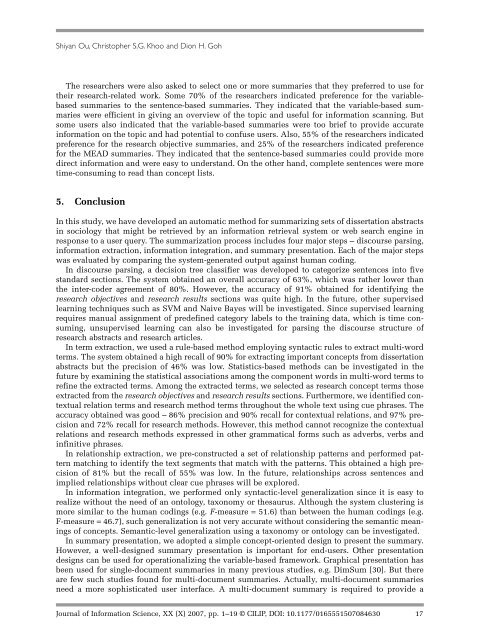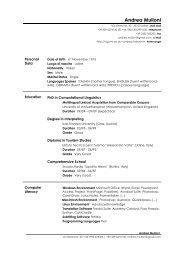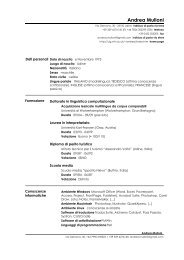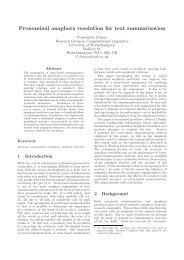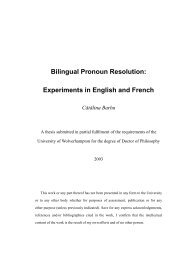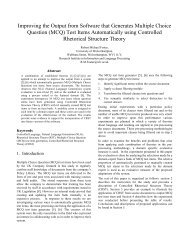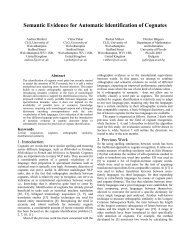Design and development of a concept-based multi ... - Citeseer
Design and development of a concept-based multi ... - Citeseer
Design and development of a concept-based multi ... - Citeseer
You also want an ePaper? Increase the reach of your titles
YUMPU automatically turns print PDFs into web optimized ePapers that Google loves.
Shiyan Ou, Christopher S.G. Khoo <strong>and</strong> Dion H. Goh<br />
The researchers were also asked to select one or more summaries that they preferred to use for<br />
their research-related work. Some 70% <strong>of</strong> the researchers indicated preference for the variable<strong>based</strong><br />
summaries to the sentence-<strong>based</strong> summaries. They indicated that the variable-<strong>based</strong> summaries<br />
were efficient in giving an overview <strong>of</strong> the topic <strong>and</strong> useful for information scanning. But<br />
some users also indicated that the variable-<strong>based</strong> summaries were too brief to provide accurate<br />
information on the topic <strong>and</strong> had potential to confuse users. Also, 55% <strong>of</strong> the researchers indicated<br />
preference for the research objective summaries, <strong>and</strong> 25% <strong>of</strong> the researchers indicated preference<br />
for the MEAD summaries. They indicated that the sentence-<strong>based</strong> summaries could provide more<br />
direct information <strong>and</strong> were easy to underst<strong>and</strong>. On the other h<strong>and</strong>, complete sentences were more<br />
time-consuming to read than <strong>concept</strong> lists.<br />
5. Conclusion<br />
In this study, we have developed an automatic method for summarizing sets <strong>of</strong> dissertation abstracts<br />
in sociology that might be retrieved by an information retrieval system or web search engine in<br />
response to a user query. The summarization process includes four major steps – discourse parsing,<br />
information extraction, information integration, <strong>and</strong> summary presentation. Each <strong>of</strong> the major steps<br />
was evaluated by comparing the system-generated output against human coding.<br />
In discourse parsing, a decision tree classifier was developed to categorize sentences into five<br />
st<strong>and</strong>ard sections. The system obtained an overall accuracy <strong>of</strong> 63%, which was rather lower than<br />
the inter-coder agreement <strong>of</strong> 80%. However, the accuracy <strong>of</strong> 91% obtained for identifying the<br />
research objectives <strong>and</strong> research results sections was quite high. In the future, other supervised<br />
learning techniques such as SVM <strong>and</strong> Naive Bayes will be investigated. Since supervised learning<br />
requires manual assignment <strong>of</strong> predefined category labels to the training data, which is time consuming,<br />
unsupervised learning can also be investigated for parsing the discourse structure <strong>of</strong><br />
research abstracts <strong>and</strong> research articles.<br />
In term extraction, we used a rule-<strong>based</strong> method employing syntactic rules to extract <strong>multi</strong>-word<br />
terms. The system obtained a high recall <strong>of</strong> 90% for extracting important <strong>concept</strong>s from dissertation<br />
abstracts but the precision <strong>of</strong> 46% was low. Statistics-<strong>based</strong> methods can be investigated in the<br />
future by examining the statistical associations among the component words in <strong>multi</strong>-word terms to<br />
refine the extracted terms. Among the extracted terms, we selected as research <strong>concept</strong> terms those<br />
extracted from the research objectives <strong>and</strong> research results sections. Furthermore, we identified contextual<br />
relation terms <strong>and</strong> research method terms throughout the whole text using cue phrases. The<br />
accuracy obtained was good – 86% precision <strong>and</strong> 90% recall for contextual relations, <strong>and</strong> 97% precision<br />
<strong>and</strong> 72% recall for research methods. However, this method cannot recognize the contextual<br />
relations <strong>and</strong> research methods expressed in other grammatical forms such as adverbs, verbs <strong>and</strong><br />
infinitive phrases.<br />
In relationship extraction, we pre-constructed a set <strong>of</strong> relationship patterns <strong>and</strong> performed pattern<br />
matching to identify the text segments that match with the patterns. This obtained a high precision<br />
<strong>of</strong> 81% but the recall <strong>of</strong> 55% was low. In the future, relationships across sentences <strong>and</strong><br />
implied relationships without clear cue phrases will be explored.<br />
In information integration, we performed only syntactic-level generalization since it is easy to<br />
realize without the need <strong>of</strong> an ontology, taxonomy or thesaurus. Although the system clustering is<br />
more similar to the human codings (e.g. F-measure = 51.6) than between the human codings (e.g.<br />
F-measure = 46.7), such generalization is not very accurate without considering the semantic meanings<br />
<strong>of</strong> <strong>concept</strong>s. Semantic-level generalization using a taxonomy or ontology can be investigated.<br />
In summary presentation, we adopted a simple <strong>concept</strong>-oriented design to present the summary.<br />
However, a well-designed summary presentation is important for end-users. Other presentation<br />
designs can be used for operationalizing the variable-<strong>based</strong> framework. Graphical presentation has<br />
been used for single-document summaries in many previous studies, e.g. DimSum [30]. But there<br />
are few such studies found for <strong>multi</strong>-document summaries. Actually, <strong>multi</strong>-document summaries<br />
need a more sophisticated user interface. A <strong>multi</strong>-document summary is required to provide a<br />
Journal <strong>of</strong> Information Science, XX (X) 2007, pp. 1–19 © CILIP, DOI: 10.1177/0165551507084630 17


